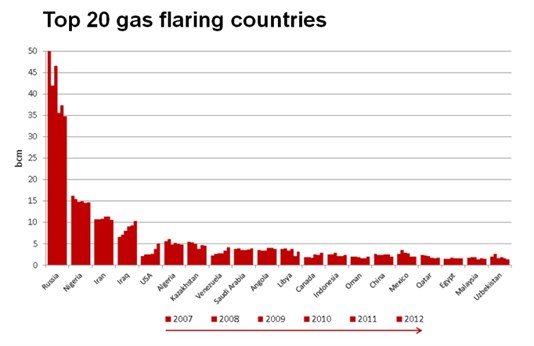Nations commit to reductions in flaring, GHG emissions
Adrienne Blume, Editor
The World Bank estimates that approximately 140 Bcm (5 Tcf) of natural gas is flared annually, resulting in the emission of more than 300 MMt of CO2 to the atmosphere. If this volume was converted to clean fuel, it would result in the production of more than 18 Bgpy.
According to the latest NASA satellite data available, the world flared approximately 3.5% of its natural gas supply in 2012. The US has the largest number of flares inside its borders, but Russia flared the most gas in that year—143 Bcm, or around 10% of the total volume emitted by EU member countries.

Source: World Bank
Flaring reduction efforts. The World Bank launched an initiative in 2015 to end routine gas flaring at oil production sites around the world by 2030. Nineteen governments, along with 20 oil and gas companies and 12 development institutions, have signed the "Zero Routine Flaring by 2030" initiative as of May 2016.
The pact seeks to curb 40% of global gas flaring by no later than 2030. It will also require governments and energy producing companies to eliminate routine flaring from new oil and gas developments.
Of the top five flaring countries in the world—which collectively accounted for approximately 76 Bcm of emissions in 2012—only Russia and the US have joined the effort so far.
North America steps forward. The US and Canada have also agreed to their own pact to reduce methane emissions by 40% to 45% from 2012 levels by 2025. The two countries hope to combat climate change in the Arctic, spur development of green technologies, and improve their relations after the US government's cancellation of the Keystone XL cross-border pipeline project last year.
In early May, the US Environmental Protection Agency (EPA) issued the first-ever federal standards designed to reduce methane emissions from oil and natural gas operations. The rules call for a decrease in domestic methane emissions of 40% from 2012 levels by 2025 and will prohibit routine flaring from new oil and gas wells.
The US EPA estimates the cost of the regulations at $530 MM in 2025, although it claims the measures will yield climate benefits worth $690 MM. The EPA claims that methane emissions have a warming effect on the planet that is at least 25 times greater than CO2.
The US and Canada have also pledged to work together to implement the UN Paris agreement on Climate Change, which was signed by more than 170 countries in April 22. The agreement seeks to reduce CO2 emissions by 40% by 2030.

- Gasum powers Equinor's platform supply vessel with bio-LNG
- ADNOC deploys pioneering AI-enabled process optimization technology
- Mexico Pacific announces long-term LNG SPA with POSCO International
- ONEOK to acquire Medallion and controlling interest in EnLink for $5.9 B
- Golar LNG signs EPC deal for $2.2-B MK II FLNG conversion project



Comments